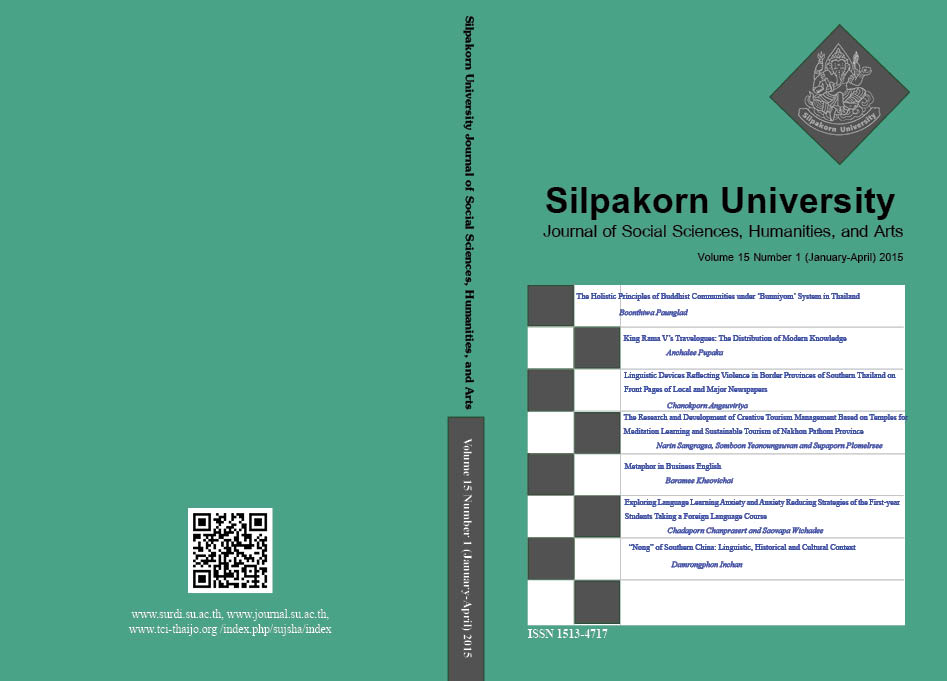The Research and Development of Creative Tourism Management Based on Temples for Meditation Learning and Sustainable Tourism of Nakhon Pathom Province
Main Article Content
Abstract
This project was implemented and based on research and development methods. It aimed to:1) study situations for management of creative tourism in Nakhon Pathom province; 2) generate a model of creative tourism management and this was driven through temples which were used for meditation learning and creating the sustainable tourism; 3) propose the good practice and 4) its guideline leading to the aforementioned management. The research procedures were divided into 4 stages: Stage 1: studying basic data; Stage 2: designing and developing research instruments; Stage 3: trying out the draft model for and Stage 4: evaluating, improving and proposing the final model. The research instruments were guidelines in-depth interviews, focus group discussion, and non-participatory observation. The collected data were qualitatively analyzed by frequency, percentage, mean, standard deviation and content analysis. The results could be demonstrated as follows:
1) The situations had its readiness for supporting to the development of creative tourism. The tourists had their chances to visit the tourist sites more increasingly and their motive of this tourism was overall evaluated at much level.
2) The one model was generated and named “MEDITATE Model”.
3) The good practices were commitment of leaders, targeting and organizing tourist organizations, building up concrete structures of community capitals and organizational cultures etc.
4) The management guidelines involved manipulating strategic plans of tourism, building up common understanding, managing and mobilizing tourist activities, Providing various learning based on temples, developing personnel for tourism, continuous public relations, preparing guide posts to tourist attractions and promoting supporting budgets from government sectors.
Downloads
Article Details
All rights reserved. Apart from citations for the purposes of research, private study, or criticism and review,no part of this publication may be reproduced, stored or transmitted in any other form without prior written permission by the publisher.
References
Sangragsa, N. (2011) Tourism for Education Textbook. Nakhon Pathom: Silpakorn University Press.
Sangragsa, N. and et al. (2011) Research and Development of Creative Tourism Management through Participation of Associates in Ratchaburi Province. Bangkok: National Research Council of Thailand.
Jittangwattana, B. (2005) Sustainable Tourism Development. Bangkok: Press and Design. Co. Ltd.
Best, J. and Kahn, J. V. (1998) Research in Education, 6th ed., New Jersey: Prentice-Hall.
Masion, P. (2009) Tourism impacts, Planning and Management, 2nd ed., Oxford: Elsevier.
McIntosh, R. W. and Goeldner, C. R. (1986) Tourism Principle Practices Philosophies, 5th ed., New York: John Wiley & sons.
Sigala, M. and Leslie, D. (Eds.) (2005) International Cultural Tourism: Management, Implications and Cases.Ohio: Elsevier Science & Technology.
UNESCO. (n.d.) Creative Industries–UNESCO Culture. [Online URL: https://portol.Unesco.org/culture/en/en.php.URL_ID=35024&URI_DO=DO_TOPIC&URI_SECTION=201.htm] accessed December 10, 2012.
Weaver, D. and Lawton, L. (2000) Tourism Management. Queensland: John Wiley & Sons.
World Commission for the Environment and Development. (1997) Sustainable Tourism and Environment. In International Tourism: A Global Perspective, 2nd ed., edited by Chuck, Y.G., pp.253-274. Madrid, Spain: World Tourism Organization.


